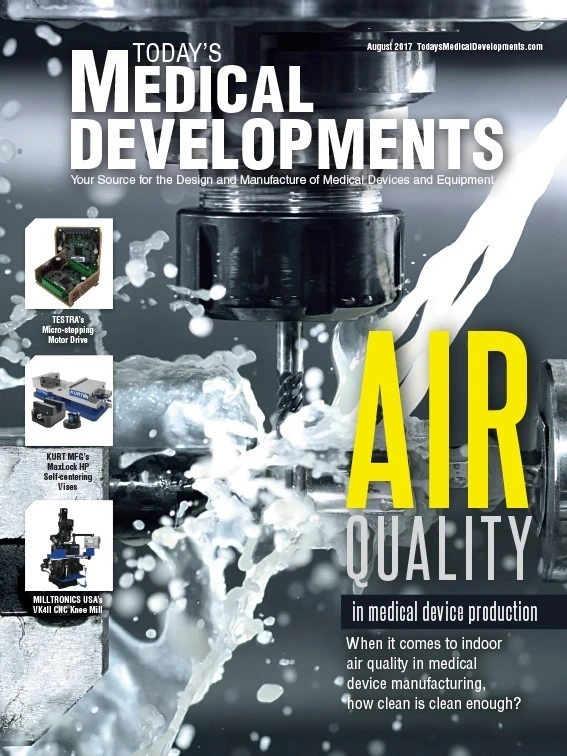
PART 1 OF A 2-PART SERIES
Part 1 looks at how poor indoor air quality (IAQ) can negatively impact productivity, product quality, and worker health.
Part 2 will cover IAQ mitigation options and the benefits of implementing a qualified, well-designed system.
Medical device manufacturing encompasses processes ranging from plastic injection molding to precision metal cutting, each with potential air quality risks. Many of these risks are shared across all manufacturing industries, from automotive to aerospace, yet many medical device manufacturers are subject to additional regulation and inspection. This is especially true for drug delivery device manufacturers who may have to follow Current Good Manufacturing Practices (CGMP) under the Federal Food, Drug, and Cosmetic Act. Some devices may need to be manufactured in a cleanroom environment under federal standards for airborne particulate cleanliness (FED-STD-209E) and ISO 14644.
Even when products are not subject to added regulatory pressures – such as hospital bed frames or gurneys – medical device manufacturers must take air quality seriously. Particulate from grinding, polishing, machining, and other manufacturing processes are unpleasant and unsightly – hardly the atmosphere a medical device manufacturer wants to present to employees, regulators, and visiting clients. Poor indoor air quality (IAQ) can negatively impact productivity, product quality, and worker health and safety, even when manufacturers are operating within Occupational Safety and Health Administration (OSHA) requirements. (See sidebar, pg. 21)
The most serious problem faced by companies with uncontrolled fumes and dust are the risks to worker health and safety. Different processes produce various types and levels of particulates, giving each process its own exposure risk profile. Some of the most common manufacturing processes for the medical device industry are:
Thermoplastic injection molding – Many medical devices are manufactured using plastics and polymers, commonly produced by thermoplastic injection molding or other processes that heat the raw material to make it moldable. Heating generates fumes that have significant health and safety hazards for workers. Polymers and resins generate hazardous volatile organic compounds (VOCs) when heated; polyvinyl chloride (PVC) can produce hydrochloric acid gas; acetyl plastics produce formaldehyde.
In addition, some of the chemicals produced by plastic processing can present an immediate asphyxiation risk if not controlled. And, many also are associated with long-term health risks including respiratory problems, central nervous system effects, and cancer.
Workers may also be exposed to plastic dust when handling raw material powders or pellets, which also can present a high combustion risk.
Machining – Often requiring lubricants, machining produces fine oil mists that can be invisible. Mists on surfaces can create slip and fall hazards for personnel. Depending on the size of particulates and the lubricant chemistry, extended inhalation may lead to asthma, chronic bronchitis, chronically impaired lung function, fibrosis of the lung, and cancer.
Cutting and grinding – Larger particulates from cutting and grinding don’t travel as deeply into the lungs as fumed particulates, but the large volume of dust produced by these applications present special health hazards. Fiberglass, metal, glass, plastics, and epoxy resins can all cause respiratory irritation; some materials are carcinogenic when inhaled. Newer materials used in some medical devices – such as nanomaterials – present special risks when cutting and grinding due to the small size of the nanoparticles, which have the potential to make their way deep into the lungs and cross into the bloodstream. The health impacts of inhaling nanoparticles are not yet fully understood.
Welding – Smoke and fumes generated by welding can vary. The toxicity and the total volume of fumes generated depend on the type of welding process, the base and filler metals used, and the composition of the welding rod. Stainless steel, used in many medical products, can produce highly toxic fumes.
Weld fumes can contain toxic nickel, copper, vanadium, molybdenum, zinc, and beryllium. These fumes hold tiny particles that are inhaled deeply into the lungs, where they have both immediate and long-term impact on worker health. Acute affects of exposure to weld fumes can include shortness of breath and respiratory irritation; eye, nose, or throat irritation; or nausea. Long-term exposure to hexavalent chromium (hex chrome), manganese, and other elements can lead to chronic or deadly exposure effects. (See sidebar, pg. 22)


A path to better IAQ
Fortunately, there are steps that you can take to ensure that your facility not only meets minimum regulatory requirements but is prepared for any changes that may come in the future. Meeting current OSHA permissible exposure limits (PELs) is a necessary start. However, many manufacturers are moving toward stricter internal standards for IAQ to meet productivity and sustainability goals. The American Conference of Governmental Industrial Hygienists (ACGIH) has developed voluntary exposure guidelines which are rapidly becoming best practices for manufacturing.
A well-designed air quality system can protect companies from legal liability and government fines and sanctions while improving worker health, satisfaction, and productivity. A qualified air quality system designer can help medical device manufacturing companies find solutions that balance costs, regulations, and goals.
We’ll take a closer look at the mitigation options in our next IAQ article.
RoboVent
www.robovent.com

Explore the August 2017 Issue
Check out more from this issue and find your next story to read.
Latest from Today's Medical Developments
- Humanoid robots to become the next US-China battleground
- Air Turbine Technology’s Air Turbine Spindles 601 Series
- Copper nanoparticles could reduce infection risk of implanted medical device
- Renishaw's TEMPUS technology, RenAM 500 metal AM system
- #52 - Manufacturing Matters - Fall 2024 Aerospace Industry Outlook with Richard Aboulafia
- Tariffs threaten small business growth, increase costs across industries
- Feed your brain on your lunch break at our upcoming Lunch + Learn!
- Robotics action plan for Europe





